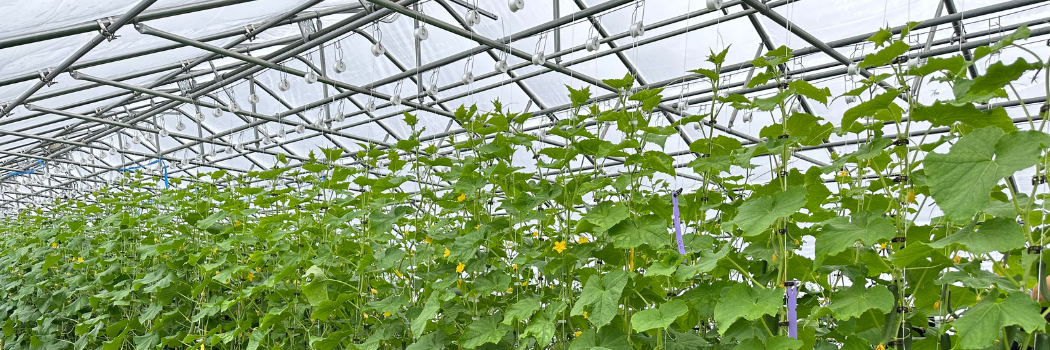- Cucumbers (Field) | Key Growing Information
- Cucumbers (Greenhouse) | Key Growing Information
- Cucumber Terminology
- Cucumber Grafting | Advantages, Materials & Technique
- Field-Grown Cucumber Varieties | Comparison Chart (PDF)
- Greenhouse Cucumber Production Guide | Tech Sheet (PDF)
- Greenhouse Cucumber Varieties | Comparison Chart (PDF)
- Video: How to Grow Cucumbers • From Seed to Harvest
- Cucumber Beetle Lure Instructions | Tech Sheet (PDF)
- How to Top-Graft Cucumbers | Tech Sheet (PDF)
- Video: How to Prune Trellised Cucumbers to Optimize Yield & Reduce Disease Pressure
- Fundamentals of Cucumber Grafting | Johnny's Educational Webinar Resources
- 'Demeter' Low-Prune Greenhouse Cucumber Variety From Johnny's
- Video: Top-Grafting Cucumbers Demonstration | Johnny's Selected Seeds
- Low-Prune Greenhouse Cucumber Production: 'Demeter' | Tech Sheet (PDF)
- Webinar Slide Deck | Fundamentals of Cucumber Grafting | 25-pp PDF
- 'Picolino' & 'Qwerty' Snacking Cucumber Varieties From Johnny's
- Video: High-Value Crops & Varieties for Your Garden • Tutorial with Niki Jabbour
- Video: Lower & Lean Demonstration | An Intro to Greenhouse Rollerhook (or Tomahook) Trellising
- Video: Fundamentals of Cucumber Grafting | Johnny's Webinar Series
- Limelight Trio — Lime Green Cucumber Varieties from Johnny's

Cucumber Terminology
When choosing cucumber varieties to suit your needs as a grower, it is helpful to understand the terminology surrounding the different types, their pollination needs, and a few other key features. Preference for one type of cucumber over another varies between individuals and markets. By familiarizing yourself with the terminology, you can better understand differences in the flowering habits, productivity, and eating qualities of the various types.
Cucumber Pollination Requirements & Flowering Habits
Cucumbers are an insect-pollinated crop; their pollen is not transferred via the wind from male flowers to female flowers but by pollinators. The specific pollination needs of different types of cucumbers vary in relation to the timing of their blossoming, the number of male versus flowers they produce, and the rate at which at which the fruits are produced from the female flowers. Relative to pollination requirements, the three main terms are monoecious, gynoecious, and parthenocarpic.
Monoecious
Monoecious cucumber varieties produce both male and female flowers on the same plant. Male flowers tend to bloom earlier than female flowers, and higher temperatures favor the development of male over female flowers.
With monoecious cucumber varieties, two general observations are that the first 10–20 flowers will be male; and for every female flower, 10–20 male flowers will be produced.
Monoecious cucumbers thus yield fruit relatively slowly over a protracted period of time. Monoecious cucumber varieties are suitable for trellising and recommended for growing scenarios where a sustained harvest over time is preferred.
Gynoecious
Gynoecious cucumber varieties produce only (or nearly only) female flowers, and in high concentrations. They are typically earlier and higheryielding than monoecious varieties. They have been bred and selected specifically for these traits.
Some gynoecious varieties require pollination in order to set fruit, and some do not. With those that do, a monoecious pollenizer variety must be planted nearby and bloom concurrently. To facilitate this, the seed of pollination-dependent gynoecious cucumber varieties is customarily blended with 10–15% of a monoecious variety’s seed. The pollenizer variety will produce predominantly male flowers that bear pollen for insect transfer to the gynoecious plants’ flowers.
If adequately pollinated, the gynoecious plants will produce cucumber fruits over a more concentrated period of time than those of monoecious varieties. Because of this concentrated fruit set, gynoecious varieties are preferred for mechanical harvest and for other situations where a heavy yield is desired over a short period of time.
Parthenocarpy
Parthenocarpic cucumber varieties do not require pollination to produce fruit. They are recommended for growing in protected culture settings, e.g., high tunnels, hoophouses, greenhouses, or wherever pollinating insects are limited or restricted.
If parthenocarpic cucumber plants are effectively isolated from pollen-producing cucumber plants, their fruits will be seedless.
Because parthenocarpic cucumber varieties produce few seeds, their seed is more costly to produce. Parthenocarpic varieties can be identified by the greenhouse symbol in our catalog and on our website.
Parthenocarpic & Gynoecious
Some cucumber varieties are both gynoecious and parthenocarpic. They characteristically produce the high yields of all-female flowers without the need for pollenizer plants.
Varieties that are both parthenocarpic and gynoecious should be protected from pollinating insects if seedless fruits are desired. Pollination will result in seeded fruits that may be considered unmarketable. Generally, varieties that are both parthenocarpic and gynoecious are grown in greenhouses or hoophouses where insect screens are installed to exclude pollinators.

